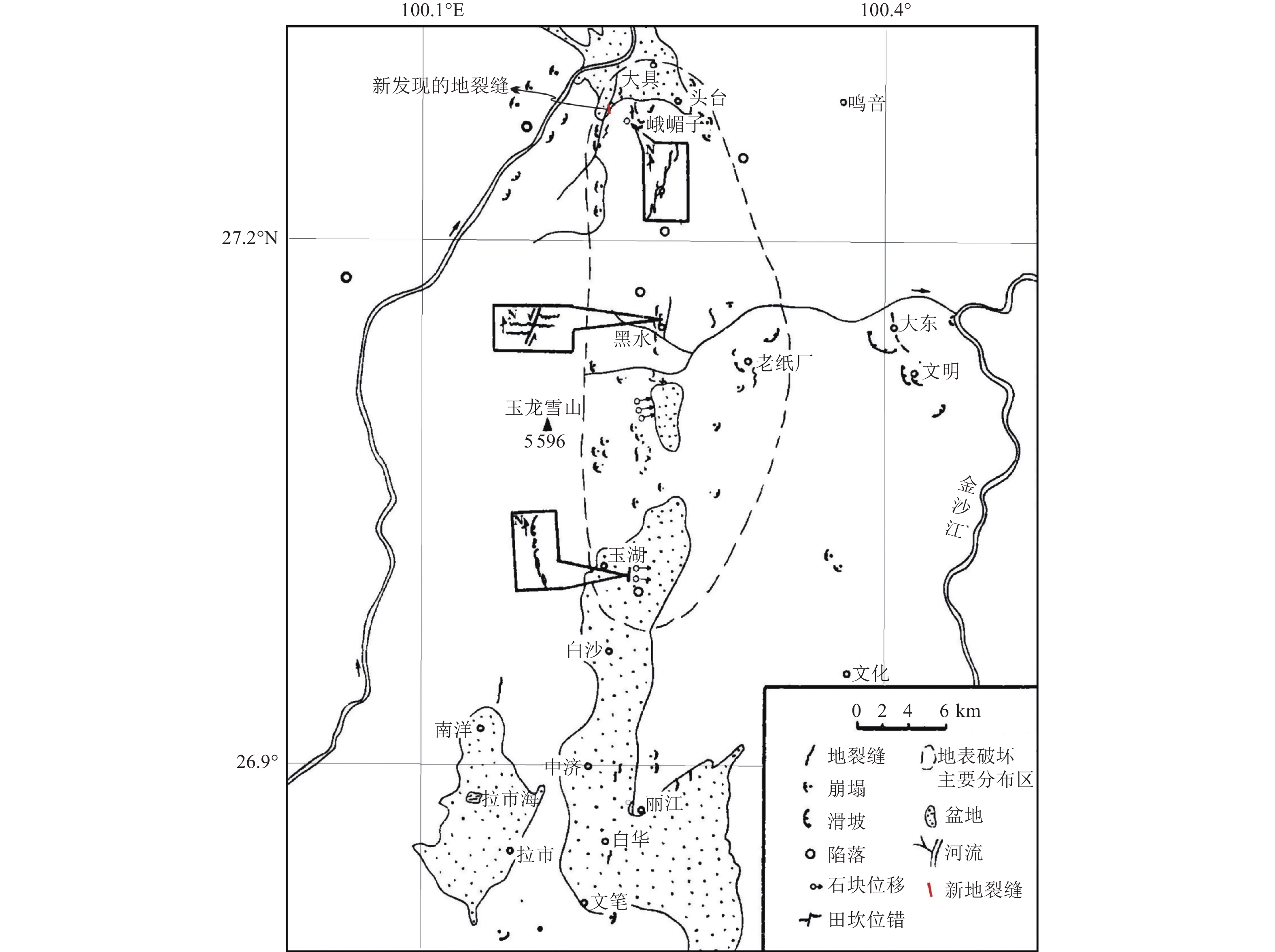New Discovery of Ground Fissures in 1996 Lijiang M7.0 Earthquake
-
摘要: 1996年2月3日云南丽江发生7.0级强烈地震,震后考察发现了广泛的地表破坏现象,主要包括地裂缝、崩塌、滑坡、地面陷落、田坎位错及地表跳石等,基本集中分布在Ⅸ度极震区范围内,但有关地震地裂缝的描述较少。近期,在进行大具盆地野外地质调查时发现1处新的地裂缝,位于云南丽江7.0级地震微观震中附近,具体位置为大具盆地南部峨嵋子村西北、将台河二级阶地上,长约35 m,总体走向350°左右,最窄处宽约0.3 m,最宽处表现为凹陷坑,宽约2.2 m。经当地村民确认,新发现的地表地裂缝是1996年丽江地震形成的,该地裂缝在震后考察时未提及。Abstract: On February 3, 1996, a strong earthquake with M7.0 occurred in Lijiang, Yunnan Province. After the earthquake, extensive surface damage phenomena were found, mainly including ground fissures, collapses, landslides, ground subsidence, ridge dislocations and surface rockfalls, which were mainly distributed in the area of magnitude IX, however, there are few descriptions of seismic ground fissures. Recently, a surface ground fissure was found in the Daju Basin during the field geological survey, which is located near the micro epicenter of Lijiang earthquake with M7.0 in Yunnan. The specific location is on the second terrace of Jiangtai River in the northwest of Emeizhi village, Southem Daju Basin. The length of the surface ground fissure is about 35 m long and the overall strike is about 350° . The narrowest part is about 0.3 m, and the widest part is a depression pit with a width of 2.2 m. According to the analysis, the newly discovered ground fissure was formed by Lijiang earthquake in 1996, and it was not mentioned in the investigation after the earthquake.
-
Key words:
- Lijiang M7.0 earthquake /
- Ground fissure /
- Daju Basin /
- Terrace /
- Depression pit
-
图 1 丽江地震地表破坏分布及新发现的地裂缝位置图(韩新民等,1997b;周光全等,1997)
Figure 1. Distribution of surface damage and location of the new ground fissure in Lijiang earthquake (according to Han等,1997;Zhou等,1997)
-
[1] 韩新民, 周瑞琦, 1997a. 丽江7.0级地震的烈度分布. 地震研究, 20(1): 35—46Han X. M. , Zhou R. Q. , 1997a. Intensity distribution of the M7.0 Lijiang earthquake. Journal of Seismological Research, 20(1): 35—46. (in Chinese) [2] 韩新民, 周瑞琦, 王锡财, 1997b. 丽江7.0级地震震害分布特征初步研究. 云南地质, 16(2): 148—155Han X. M. , Zhou R. Q. , Wang X. C. , 1997b. A preliminary study on the distribution characteristics of the 7.0 scale quake damage in Lijiang. Yunnan Geology, 16(2): 148—155. (in Chinese) [3] 皇甫岗, 1997.1996年2月3日云南丽江7.0级地震. 地震研究, 20(1): 1—8Huangfu G. , 1997. The M7.0 Lijiang earthquake in Yunnan on February 3, 1996. Journal of Seismological Research, 20(1): 1—8. (in Chinese) [4] 王绍晋, 龙晓帆, 罗淑进, 1997. 丽江地震序列的震源机制、发震应力场和破裂特征. 地震研究, 20(1): 26—34Wang S. J. , Long X. F. , Luo S. J. , 1997. The focal mechanism, seismogenic stress field and rupture characteristics of the Lijiang earthquake sequence. Journal of Seismological Research, 20(1): 26—34. (in Chinese) [5] 徐扬, 菊地正幸, 苏有锦, 1998. 1996年2月3日云南丽江地震震源过程的体波反演. 地震学报, 20(2): 113—117. doi: 10.3321/j.issn:0253-3782.1998.02.001 [6] 张建国, 周瑞琦, 吴伯黔等, 1997. 丽江7.0级地震地表破裂与形变特征. 地震研究, 20(1): 58—65Zhang J. G. , Zhou R. Q. , Wu B. Q. , et al. , 1997. The characteristics of surface rupture and deformation for the M7.0 Lijiang earthquake. Journal of Seismological Research, 20(1): 58—65. (in Chinese) [7] 周光全, 张建国, 周瑞琦等, 1997. 丽江7.0级地震的地震地质构造背景分析. 地震研究, 20(1): 92—100Zhou G. Q. , Zhang J. G. , Zhou R. Q. , et al. , 1997. Anlysis on sesimological tectonic background of the M7.0 Lijiang earthquake. Journal of Seismological Research, 20(1): 92—100. (in Chinese) -




 下载:
下载:


